Page 34 of 637
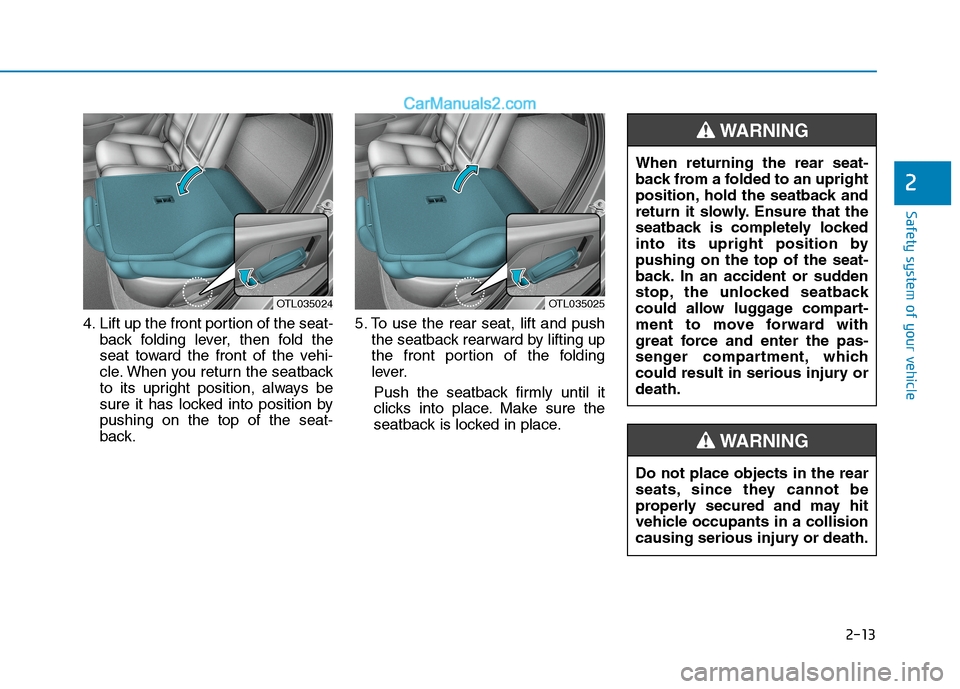
2-13
Safety system of your vehicle
2
4. Lift up the front portion of the seat-
back folding lever, then fold the
seat toward the front of the vehi-
cle. When you return the seatback
to its upright position, always be
sure it has locked into position by
pushing on the top of the seat-
back.5. To use the rear seat, lift and push
the seatback rearward by lifting up
the front portion of the folding
lever.
Push the seatback firmly until it
clicks into place. Make sure the
seatback is locked in place.
OTL035024OTL035025
Do not place objects in the rear
seats, since they cannot be
properly secured and may hit
vehicle occupants in a collision
causing serious injury or death.
WARNING
When returning the rear seat-
back from a folded to an upright
position, hold the seatback and
return it slowly. Ensure that the
seatback is completely locked
into its upright position by
pushing on the top of the seat-
back. In an accident or sudden
stop, the unlocked seatback
could allow luggage compart-
ment to move forward with
great force and enter the pas-
senger compartment, which
could result in serious injury or
death.
WARNING
Page 36 of 637
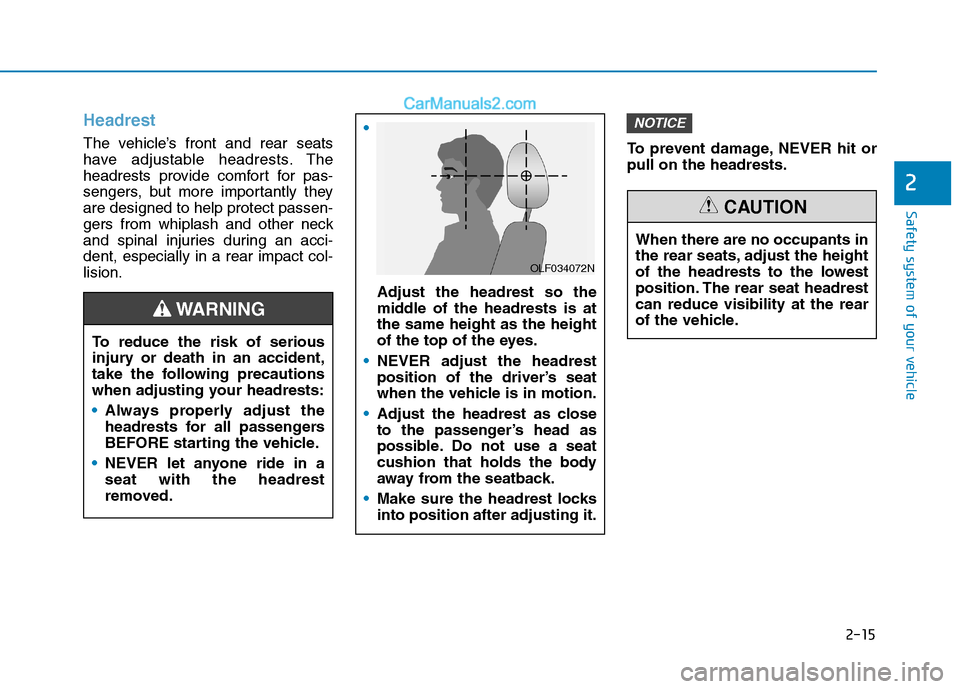
2-15
Safety system of your vehicle
2
Headrest
The vehicle’s front and rear seats
have adjustable headrests. The
headrests provide comfort for pas-
sengers, but more importantly they
are designed to help protect passen-
gers from whiplash and other neck
and spinal injuries during an acci-
dent, especially in a rear impact col-
lision.To prevent damage, NEVER hit or
pull on the headrests.
NOTICE
When there are no occupants in
the rear seats, adjust the height
of the headrests to the lowest
position. The rear seat headrest
can reduce visibility at the rear
of the vehicle.
CAUTION
To reduce the risk of serious
injury or death in an accident,
take the following precautions
when adjusting your headrests:
Always properly adjust the
headrests for all passengers
BEFORE starting the vehicle.
NEVER let anyone ride in a
seat with the headrest
removed.
Adjust the headrest so the
middle of the headrests is at
the same height as the height
of the top of the eyes.
NEVER adjust the headrest
position of the driver’s seat
when the vehicle is in motion.
Adjust the headrest as close
to the passenger’s head as
possible. Do not use a seat
cushion that holds the body
away from the seatback.
Make sure the headrest locks
into position after adjusting it.
WARNING
OLF034072N
Page 37 of 637
2-16
Safety system of your vehicle
Front seat headrests
The driver’s and front passenger’s
seats are equipped with adjustable
headrests for the passengers safety
and comfort.
Forward and rearward adjustment
The headrest may be adjusted for-
ward to 3 different positions by
pulling the headrest forward to the
desired detent. To adjust the head-
rest to it’s furthest rearwards posi-
tion, pull it fully forward to the farthest
position and release it.
Adjusting the height up and down
To raise the headrest:
1. Pull it up to the desired position
(1).
To lower the headrest:
1. Push and hold the release button
(2) on the headrest support.
2. Lower the headrest to the desired
position (3).
OLMB033009
OTL035014OTL035009
Page 39 of 637
2-18
Safety system of your vehicle
To reinstall the headrest :
1. Recline the seatback.
2. Put the headrest poles (2) into the
holes whilst pressing the release
button (1).3. Adjust the headrest to the appro-
priate height.
4. Recline the seatback (4) with the
seatback angle lever or switch (3).
Rear seat headrests
The rear seats are equipped with
headrests in all the seating positions
for the passenger’s safety and com-
for t.
OLMB033016
Always make sure the headrest
locks into position after rein-
stalling and adjusting it proper-
ly.
WARNING
OTL035012R
■Type A
OTLE035013R
■Type B
Page 40 of 637
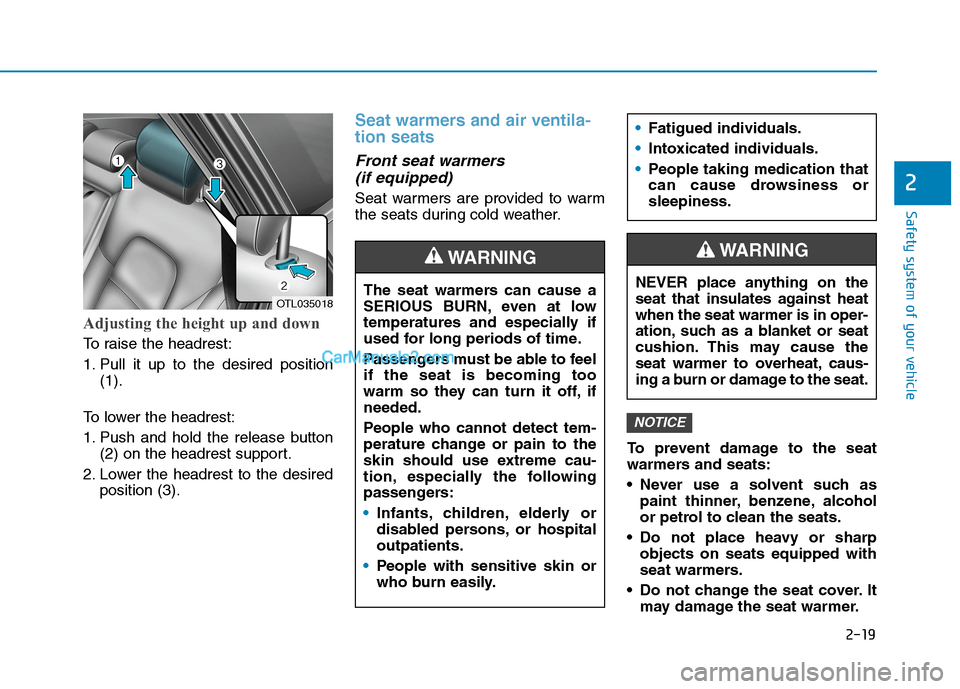
2-19
Safety system of your vehicle
2
Adjusting the height up and down
To raise the headrest:
1. Pull it up to the desired position
(1).
To lower the headrest:
1. Push and hold the release button
(2) on the headrest support.
2. Lower the headrest to the desired
position (3).
Seat warmers and air ventila-
tion seats
Front seat warmers
(if equipped)
Seat warmers are provided to warm
the seats during cold weather.
To prevent damage to the seat
warmers and seats:
Never use a solvent such as
paint thinner, benzene, alcohol
or petrol to clean the seats.
Do not place heavy or sharp
objects on seats equipped with
seat warmers.
Do not change the seat cover. It
may damage the seat warmer.
NOTICE
The seat warmers can cause a
SERIOUS BURN, even at low
temperatures and especially if
used for long periods of time.
Passengers must be able to feel
if the seat is becoming too
warm so they can turn it off, if
needed.
People who cannot detect tem-
perature change or pain to the
skin should use extreme cau-
tion, especially the following
passengers:
Infants, children, elderly or
disabled persons, or hospital
outpatients.
People with sensitive skin or
who burn easily.
Fatigued individuals.
Intoxicated individuals.
People taking medication that
can cause drowsiness or
sleepiness.
WARNING
NEVER place anything on the
seat that insulates against heat
when the seat warmer is in oper-
ation, such as a blanket or seat
cushion. This may cause the
seat warmer to overheat, caus-
ing a burn or damage to the seat.
WARNING
OTL035018
Page 42 of 637

2-21
Safety system of your vehicle
2
Front air ventilation seat
(if equipped)The air ventilation seats are provided
to cool the front seats by blowing air
through small vent holes on the sur-
face of the seat cushions and seat-
backs.
When the operation of the air ventila-
tion seat is not needed, keep the
switches in the OFF position.
Whilst the engine is running, push the
switch to cool the driver's seat or the
front passenger's seat (if equipped).
Each time you push the switch, the
airflow changes as follows:
When pressing the switch for more
than 1.5 seconds with the air venti-
lation seat operating, the operation
will turn OFF.
The air ventilation seats default to
the OFF position whenever the
ignition switch is placed to the ON
position.To prevent damage to the air ven-
tilation seat:
Use the air ventilation seat ONLY
when the climate control system
is on. Using the air ventilation
seat for prolonged periods of
time with the climate control
system off could cause the air
ventilation seat to malfunction.
Never use a solvent such as
paint thinner, benzene, alcohol
or petrol to clean the seats.
Avoid spilling liquids on the sur-
face of the front seats and seat-
backs; this may cause the air
vent holes to become blocked
and not work properly.
Do not place materials such as
plastic bags or newspapers
under the seats. They may block
the air intake causing the air
vents to not work properly.NOTICE
OFF HIGH ( )
LOW ( ) MIDDLE ( )
→→
→
→OTLE035016
■Type A
OTLE035015
■Type B
Page 44 of 637
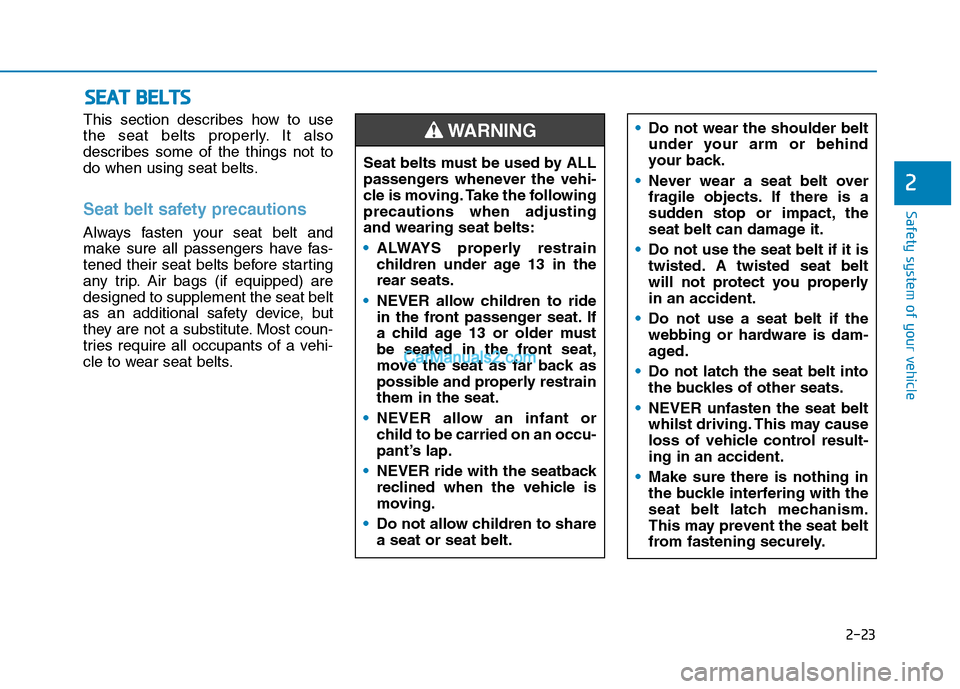
2-23
Safety system of your vehicle
This section describes how to use
the seat belts properly. It also
describes some of the things not to
do when using seat belts.
Seat belt safety precautions
Always fasten your seat belt and
make sure all passengers have fas-
tened their seat belts before starting
any trip. Air bags (if equipped) are
designed to supplement the seat belt
as an additional safety device, but
they are not a substitute. Most coun-
tries require all occupants of a vehi-
cle to wear seat belts.
S SE
EA
AT
T
B
BE
EL
LT
TS
S
2
Seat belts must be used by ALL
passengers whenever the vehi-
cle is moving. Take the following
precautions when adjusting
and wearing seat belts:
ALWAYS properly restrain
children under age 13 in the
rear seats.
NEVER allow children to ride
in the front passenger seat. If
a child age 13 or older must
be seated in the front seat,
move the seat as far back as
possible and properly restrain
them in the seat.
NEVER allow an infant or
child to be carried on an occu-
pant’s lap.
NEVER ride with the seatback
reclined when the vehicle is
moving.
Do not allow children to share
a seat or seat belt.
WARNING Do not wear the shoulder belt
under your arm or behind
your back.
Never wear a seat belt over
fragile objects. If there is a
sudden stop or impact, the
seat belt can damage it.
Do not use the seat belt if it is
twisted. A twisted seat belt
will not protect you properly
in an accident.
Do not use a seat belt if the
webbing or hardware is dam-
aged.
Do not latch the seat belt into
the buckles of other seats.
NEVER unfasten the seat belt
whilst driving. This may cause
loss of vehicle control result-
ing in an accident.
Make sure there is nothing in
the buckle interfering with the
seat belt latch mechanism.
This may prevent the seat belt
from fastening securely.
Page 55 of 637
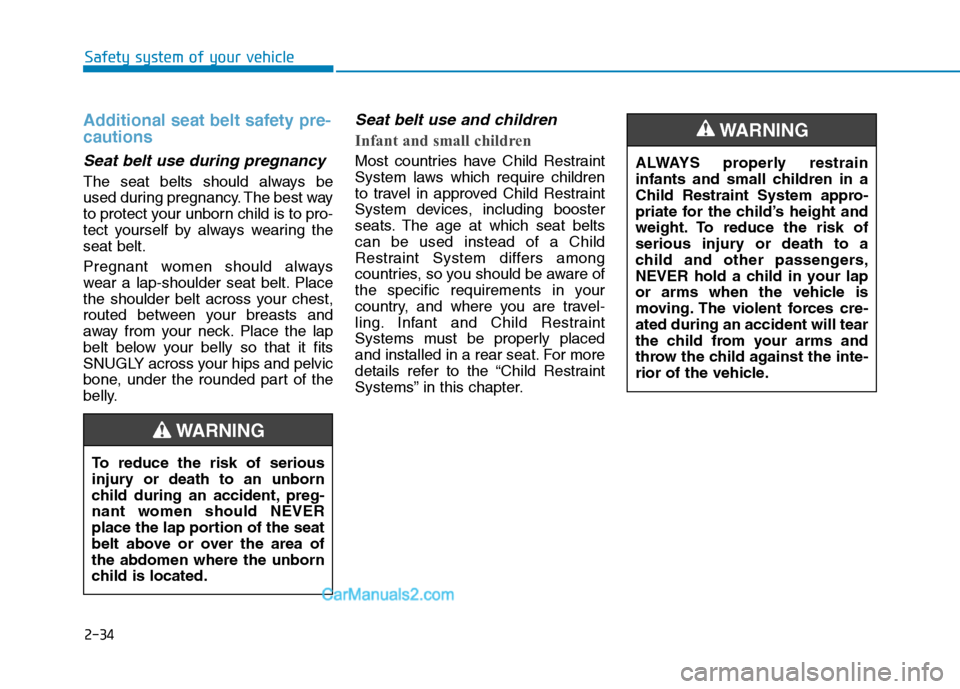
2-34
Safety system of your vehicle
Additional seat belt safety pre-
cautions
Seat belt use during pregnancy
The seat belts should always be
used during pregnancy. The best way
to protect your unborn child is to pro-
tect yourself by always wearing the
seat belt.
Pregnant women should always
wear a lap-shoulder seat belt. Place
the shoulder belt across your chest,
routed between your breasts and
away from your neck. Place the lap
belt below your belly so that it fits
SNUGLY across your hips and pelvic
bone, under the rounded part of the
belly.
Seat belt use and children
Infant and small children
Most countries have Child Restraint
System laws which require children
to travel in approved Child Restraint
System devices, including booster
seats. The age at which seat belts
can be used instead of a Child
Restraint System differs among
countries, so you should be aware of
the specific requirements in your
country, and where you are travel-
ling. Infant and Child Restraint
Systems must be properly placed
and installed in a rear seat. For more
details refer to the “Child Restraint
Systems” in this chapter.ALWAYS properly restrain
infants and small children in a
Child Restraint System appro-
priate for the child’s height and
weight. To reduce the risk of
serious injury or death to a
child and other passengers,
NEVER hold a child in your lap
or arms when the vehicle is
moving. The violent forces cre-
ated during an accident will tear
the child from your arms and
throw the child against the inte-
rior of the vehicle.
WARNING
To reduce the risk of serious
injury or death to an unborn
child during an accident, preg-
nant women should NEVER
place the lap portion of the seat
belt above or over the area of
the abdomen where the unborn
child is located.
WARNING